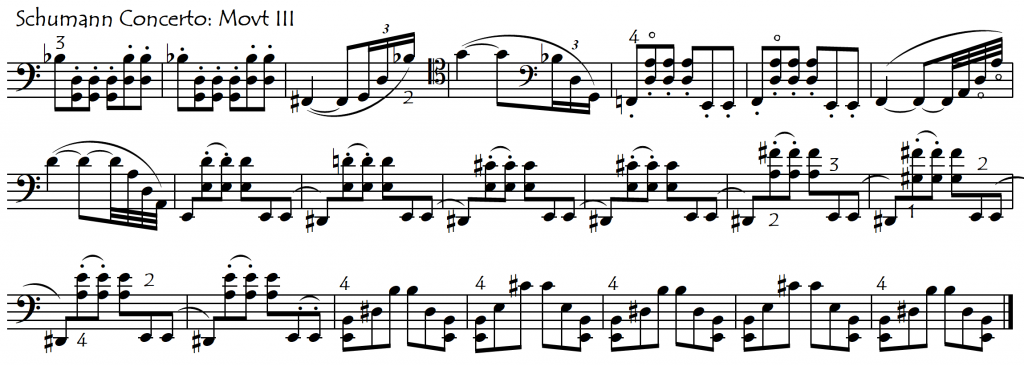Cello String Crossings: Four Strings
This page deals only with the right-hand (bow) aspect of cello string-crossings. To look at the lefthand string-crossing factors click on the highlighted link.
For practice purposes we can divide string-crossing passages involving four strings into several different types:
1: REGULAR: chords (and broken chords) in which there is one note per string:

2: IRREGULAR: arpeggio type figures in which there is sometimes more than one note per string

With respect to the slurring, both the regular and irregular types can (and should) be practised with
- completely separate bow strokes
- completely slurred bowings
- mixed slurred/separate bowings
3: WITH LEAPS: passages with jumps to non-adjacent strings

There is no point practising “leaping passages” with legato slurs because the middle string(s) will unavoidably be sounded. We can however practice them with separate and portato bow strokes, in which the bow stops its horizontal movement during the string-crossing. Leaps across the strings are dealt with on their own dedicated page:
Links to compilations of exercises and repertoire excerpts involving four strings can be found here below. Very often repertoire passages will involve a combination of 3 and 4-string crossings. These mixed passages are included here in the four-string compilations. Each passage/exercise can be practised with many different bowings: slurred, separate, mixed, spiccato etc:
Regular Chordal Passages: REPERTOIRE EXCERPTS Regular Chordal Passages: EXERCISES
Irregular Arpeggio Passages: REPERTOIRE EXCERPTS Irregular Arpeggio Passages: EXERCISES
Of course, these subdivisions into the different categories of regular, irregular and leaps are only useful for practice purposes. In the repertoire, all the different techniques are often combined into delicious cocktails (recipes) of varied flavours, as in the following example from the Schumann Concerto:

We can use a compilation of Four-String Chord Sequences as a base on which to create our own bowing exercises. This is what Sevcik did for the violin and it is a wonderfully useful pedagogical tool, allowing us to master and then reinforce all the many different four-string-crossing bowing problems that we will find in the repertoire.
